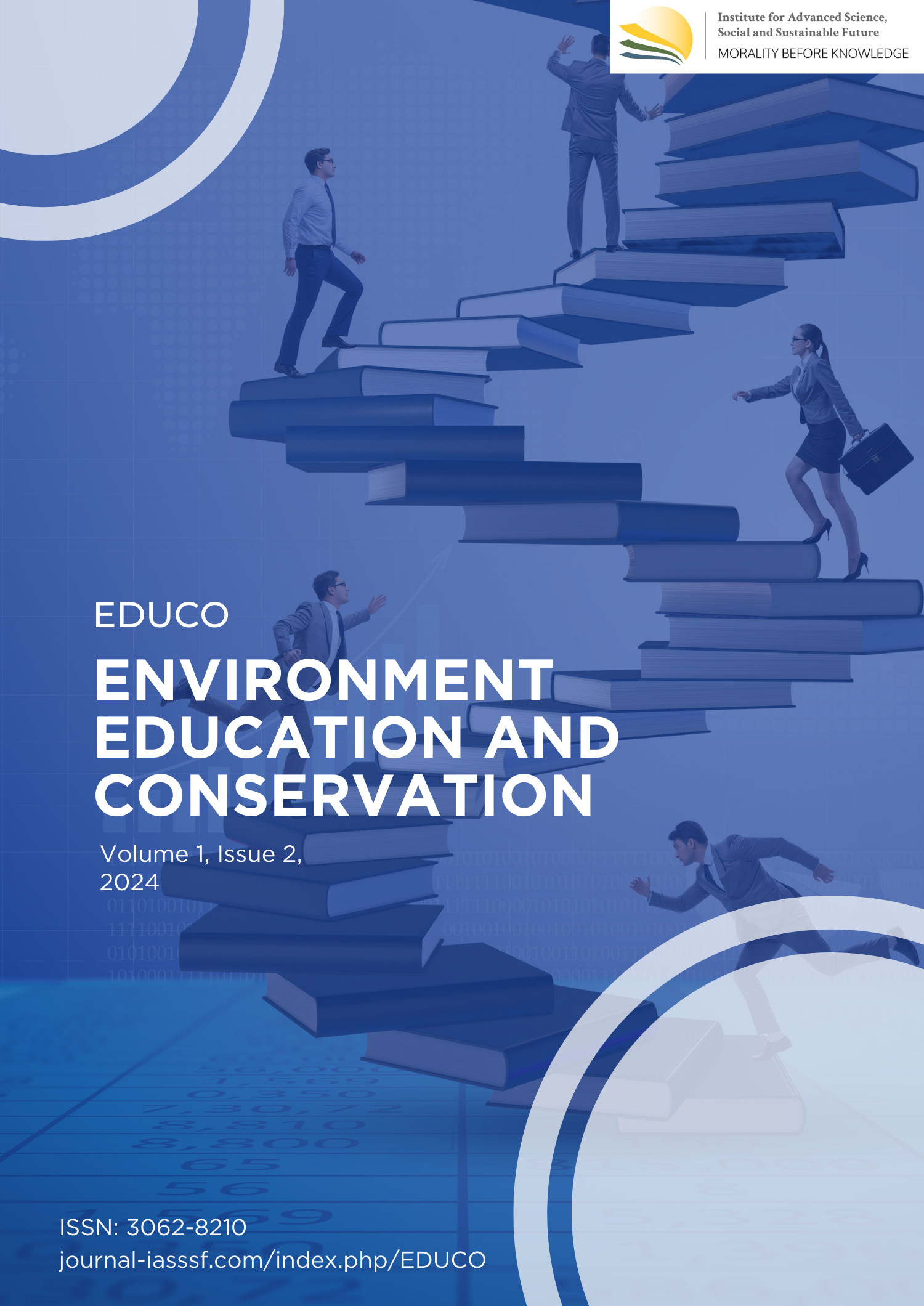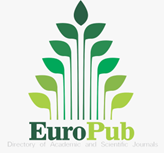Public awareness on wildlife conservation: A systematic literature review
DOI:
https://doi.org/10.61511/educo.v1i2.2024.1652Keywords:
systematic literature review, public awareness, wildlife conservationAbstract
Background: Wildlife conservation has become an increasingly urgent global issue as biodiversity continues to decline. Despite the critical importance of conservation, public awareness regarding its significance varies widely across different countries. By exploring how different countries approach this issue, the study seeks to identify strategies to improve awareness and contribute to the global discourse on wildlife preservation. Methods: This research employed a qualitative approach using a systematic literature review. The review process utilized tools such as Publish or Perish software and the Preferred Reporting Items for Systematic Reviews and Meta-Analyses (PRISMA) guidelines to ensure a comprehensive analysis. A total of nine journal articles were selected for comparison through a structured identification and screening process. Relationships among the data were further analyzed and visualized using VOSviewer software, providing an in-depth understanding of the trends and patterns in public awareness and conservation strategies across different countries. Findings: The results of the systematic literature review revealed that all nine countries studied recognize the importance of wildlife conservation in preserving biodiversity. Despite this shared understanding, the strategies employed to enhance public awareness differ significantly, reflecting cultural, social, and institutional contexts. Effective methods identified include integrated communication strategies, which involve mass media and public relations campaigns to disseminate conservation messages. Educational initiatives, such as incorporating conservation topics into school curricula and public lectures, also emerged as key approaches. Additionally, leveraging animal-related content, including videos and storytelling rooted in local wisdom, has proven effective in engaging communities and fostering a deeper connection to conservation efforts. Novelty/Originality of this article: This research contributes to the field of wildlife conservation by providing a comparative analysis of public awareness strategies across diverse countries. The study highlights the critical role of public awareness in ensuring the success of conservation programs and offers actionable insights into how different approaches can be adapted to various contexts. The novelty lies in its emphasis on cross-cultural strategies, enabling countries to learn from one another and adopt best practices to enhance public participation in conservation efforts.
References
Alam, R., & Nayak, D. (2024). Developing local support for wildlife conservation through community-based ecotourism: A study of Jim Corbett Tiger Reserve, India. Tourism Planning & Development, 1–25. https://doi.org/10.1080/21568316.2024.2347227
Amannullah, Gantjang, dkk. (2023). Laporan pelaksanaan pencapaian tujuan pembangunan berkelanjutan. Kedeputian Bidang Kemaritiman dan Sumber Daya Alam, Kementerian Perencanaan Pembangunan Nasional/Badan Perencanaan Pembangunan Nasional.
Anggraini, F. D., Prasetyo, A.P.B., & Iswari, R. S. (2019). Promoting children’s conservation awareness of Macaca fascicularis through narrative video. Unnes Science Education Journal.
Ayuningtyas, A. D. (2024). Di belakang Brasil, Indonesia miliki ragam hayati terbesar kedua di dunia. GoodStats. https://goodstats.id/article/di-belakang-brazil-indonesia-miliki-ragam-hayati-terbesar-kedua-di-dunia-xnQCr
Barker, M. (2024, June 29). Benefits of community involvement in wildlife conservation. Wildteamuk. https://www.wildteam.org.uk/post/benefits-of-community-involvement-in-wildlife-conservation
Bergman, J. N., Buxton, R. T., Lin, H., Lenda, M., Attinello, K., Hajdasz, A. C., Rivest, S. A., Nguyen, T. T., Cooke, S. J., & Bennett, J. R. (2022). Evaluating the benefits and risks of social media for wildlife conservation. FACETS, 7, 360–397. https://doi.org/10.1139/facets-2021-0112
Bimo, E. S. (2021b). Laporan IUCN 2021, Indonesia punya 189 fauna kritis terancam punah, 26 spesies adalah mamalia. KOMPAS.tv. https://www.kompas.tv/internasional/208546/laporan-iucn-2021-indonesia-punya-189-fauna-kritis-terancam-punah-26-spesies-adalah-mamalia?page=all
Chetia, H., & Chatakonda, M. K. (2024). Rarest of the rare: People’s awareness and perceptions about the woolly flying squirrel in Uttarakhand Himalaya, Northern India. Integrative Conservation. https://doi.org/10.1002/inc3.62
Darajati, W., Pratiwi, S., Herwinda, E., Radiansyah, A. D., Nalangm, V. S., Nooryanto, B., Rahajoe, J. S., Ubaidillah, R., Maryanto, I., Kurniawan, R., Prasetyo, T. A., Rahim, A., Jefferson, J., Hakim, F. (2016). Indonesian biodiversity strategy and action plan, 2015-2020. Kementerian Perencanaan Pembangunan Nasional/Badan Perencanaan Pembangunan Nasional (Kementerian PPN/Bappenas).
Profauna (n.d.). Fakta tentang Satwa Liar Indonesia. https://www.profauna.net/id/fakta-satwa-liar-di-indonesia
Fischer, H. A., Bernard, M. L., Kemppinen, K., & Gerber, L. R. (2022). Conservation awareness through social media. Journal of Environmental Studies and Sciences, 13(1), 23–30. https://doi.org/10.1007/s13412-022-00795-5
Gessa, S. J., Tayeebwa, W., Tumwesigye, C., & Rothman, J. M. (2024). The role of public relations in wildlife conservation: Examples from Uganda. Tropical Conservation Science, 17. https://doi.org/10.1177/19400829241233471
Guidino, C., Cortez‐Casamayor, S., Campbell, E., Cajaleón, M., Peña‐Cutimbo, N., Delgado, M., Moran‐Valverde, J., Arbulu‐Vercauteren, Y., & Pacheco, A. S. (2023). Public knowledge and awareness of the conservation of the common bottlenose dolphin (Tursiops truncatus) along the central coast of Peru. Aquatic Conservation Marine and Freshwater Ecosystems, 33(4), 397–408. https://doi.org/10.1002/aqc.3925
Latif, S. A. A., Yazid, F. N., & Farudz, B. Z. M. (2024). The examination of conservation awareness, future sustainability, and conservation readiness on tourists’ attitude towards marine conservation behavior in Malaysia’s Marine Parks. IOP Conference Series: Earth and Environmental Science, 1366(1), 012035. https://doi.org/10.1088/1755-1315/1366/1/012035
Leighton, G. R. M., & Serieys, L. E. K. (2024). Wild cats on the Internet: The role of social media in popularising caracals in South Africa. Environmental Communication, 1–15. https://doi.org/10.1080/17524032.2024.2402466
Marras, C. (2021, April 15). Ecotourism: A resource for the conservation of wildlife. Ecobnb. https://ecobnb.com/blog/2021/04/ecotourism-conservation-wildlife/
Miller, A. B., Cox, C., & Morse, W. C. (2023). Ecotourism, wildlife conservation, and agriculture in Costa Rica through a social-ecological systems lens. Frontiers in Sustainable Tourism, 2. https://doi.org/10.3389/frsut.2023.1179887
Ochieng, C. N., Thenya, T., Shah, P., & Odwe, G. (2021). Awareness of traditional knowledge and attitudes towards wildlife conservation among Maasai communities: The case of Enkusero Sampu Conservancy, Kajiado County in Kenya. African Journal of Ecology, 59(3), 712–723. https://doi.org/10.1111/aje.12872
Saputro, G. E., & Haryadi, T. (2021). Pemanfaatan film pendek dokumenter sebagai media edukasi pelestarian kura-kura Cuora amboinensis. Desain Komunikasi Visual Manajemen Desain Dan Periklanan (Demandia), 6(1), 148. https://doi.org/10.25124/demandia.v6i1.3465
Sartika, R. E. A. (2023, June 20). Satwa liar menjaga keberlangsungan hidup manusia. KOMPAS.com. https://www.kompas.com/sains/read/2023/06/20/200000423/satwa-liar-menjaga-keberlangsungan-hidup-manusia?page=all#google_vignette
Sahusilawane, J., & Latupapua, L. (2023). Konservasi satwa liar berbasis kearifan lokal di Negeri Hutumuri Kecamatan Leitimur Selatan Kota Ambon. Jurnal Inovasi Pengabdian Dan Pemberdayaan Masyarakat, 3(2), 461–468. https://doi.org/10.54082/jippm.171
Shreedhar, G. (2021). Evaluating the impact of storytelling in Facebook advertisements on wildlife conservation engagement: Lessons and challenges. Conservation Science and Practice, 3(11). https://doi.org/10.1111/csp2.534
Siaran Pers Kementerian Lingkungan Hidup dan Kehutanan Republik Indonesia Nomor: SP. 153/HUMAS/PPIP/HMS.3/05/2023 berjudul Hari Keanekaragaman Hayati: Pembangunan berkelanjutan dalam keselarasan dengan alam. https://ppid.menlhk.go.id/berita/siaran-pers/7184/hari-keanekaragaman-hayati-pembangunan-berkelanjutan-dalam-keselarasan-dengan-alam
Siswanto, S. (2010). Systematic review sebagai metode penelitian untuk mensintesis hasil-hasil penelitian (sebuah pengantar). Buletin Penelitian Sistem Kesehatan, 13(4), 21312. https://ejournal.litbang.kemkes.go.id/index.php/hsr/article/view/2766/1500
Sobroza, T. V., De Menezes Medeiros, A. S., Batista, R. N. M., & Gordo, M. (2022). “Sauins” on touchscreens: Social media as a tool for pied tamarin conservation awareness. Neotropical Primates, 28(1–2), 62–66. https://doi.org/10.62015/np.2022.v28.223
Sutoyo, S. (2010). Keanekaragaman hayati Indonesia: Suatu tinjauan, masalah, dan pemecahannya. Buana Sains, 10(2), 101–106. https://doi.org/10.33366/bs.v10i2.199
Tarimo, K. V., & Olotu, M. I. (2020). Local community participation in wildlife conservation and management in Rungwa Game Reserve, Tanzania. Environmental & Socio-economic Studies, 8(2), 21–31. https://doi.org/10.2478/environ-2020-0009
Truong, D. D. (2022). Community awareness and participation in biodiversity conservation at Phong Nha-Ke Bang National Park, Vietnam. Biodiversitas Journal of Biological Diversity, 23(1). https://doi.org/10.13057/biodiv/d230163
Van Vierssen Trip, N., MacPhail, V. J., Colla, S. R., & Olivastri, B. (2020). Examining the public’s awareness of bee (Hymenoptera: Apoidae: Anthophila) conservation in Canada. Conservation Science and Practice, 2(12). https://doi.org/10.1111/csp2.293
Vladova, I. (2023). Towards a more sustainable future: The importance of environmental education in developing attitudes towards environmental protection. SHS Web of Conferences, 176, 01009. https://doi.org/10.1051/shsconf/202317601009











